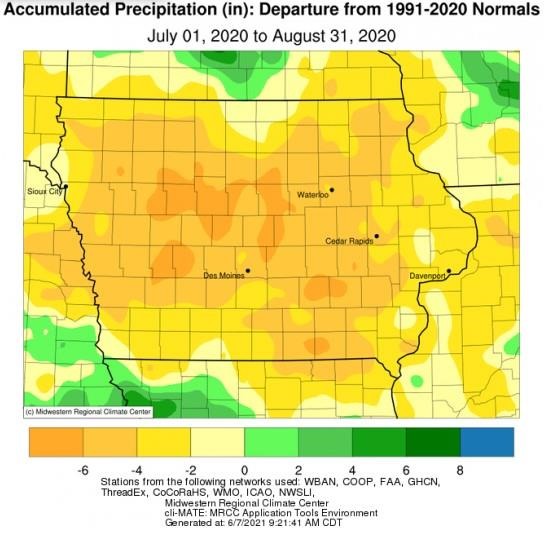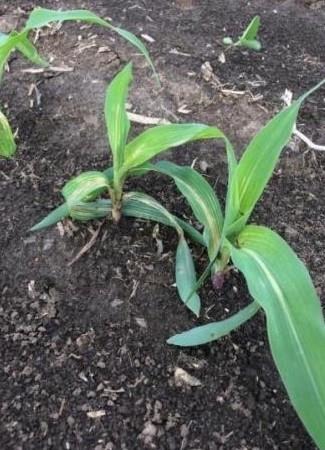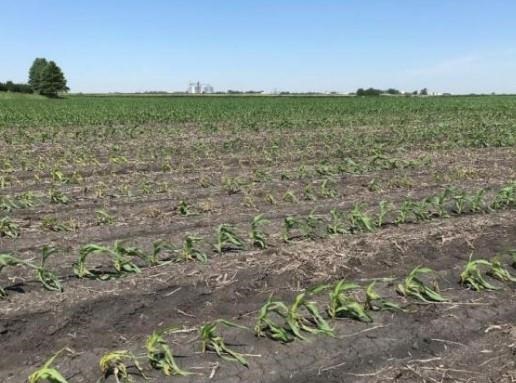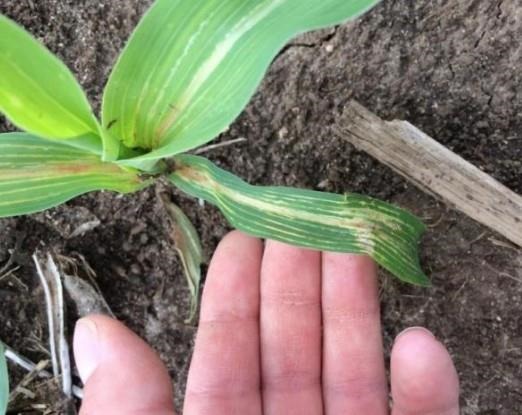By Meaghan Anderson
ISU Extension and Outreach Field Agronomists recently highlighted a significant number of phone calls related to fomesafen carryover injury to corn rotated from 2020 soybeans. In some cases, this injury has been misidentified as other issues, like boron deficiency. There are several factors resulting in this injury: 1) continued problems with waterhemp result in late-season applications in soybean, 2) fomesafen is relatively persistent, and 3) many areas of Iowa received less than average late-season rainfall in 2020. In most cases, this carryover injury has been limited to relatively small sprayer overlap areas, though some fields are showing injury on a more widespread area.
Characteristics of the primary products used postemergence to control waterhemp in Iowa are listed in Table 1. For a herbicide to pose carryover risks, it must persist at toxic concentrations into the following growing season and be biologically available. Both fomesafen and glyphosate are relatively persistent (longer half-life) compared to the some other herbicides. The KOC is a measure of how tightly a chemical is held to soil colloids. As the KOC value increases, less herbicide is available to be absorbed by plants. Whereas fomesafen can be readily absorbed by plants due to low adsorption to soil colloids, glyphosate is unavailable to plants due to tight binding to soil particles.
Table 1. Herbicide characteristics influencing carryover potential. Herbicide Handbook, 10th Edition. Weed Science Society of America.
Active ingredient | Trade name | Half-life | Availability (KOC) |
fomesafen | Flexstar | 100 days | 60 |
lactofen | Cobra | 3 days | 10,000 |
glufosinate | Liberty | 7 days | 100 |
dicamba | Xtendimax | 14 days | 2 |
glyphosate | Roundup | 47 days | 24,000 |
The relatively long half-life of fomesafen, combined with below average rainfall late-season rain in Iowa, is the reason for the increased issues with carryover in 2021. Much of the state received 4-6+ fewer inches of rain than normal during July and August of 2020 (Figure 1).

The primary symptom of fomesafen injury is striped leaves due to chlorotic or necrotic veins on the leaves (Figures 2, 3, and 4). Other factors can cause striping on leaves, but fomesafen is unique in that the veins are affected rather than interveinal tissue. Some of the leaves may fold over midway due to loss of integrity of the leaf midvein. Frequently only two or three leaves are affected and injured plants recover quickly with no visible injury to subsequent leaves. However, at times there can be stand loss and the only way to determine the potential impact is to determine the percentage of plants affected and closely monitor the rate of recovery.
 Figure 2. Veinal chlorosis typical of fomesafen carryover on corn
Figure 2. Veinal chlorosis typical of fomesafen carryover on corn Figure 3. Fomesafen injury in a 2020 corn field near field entrance due to rate control issues with sprayer in 2019.
Figure 3. Fomesafen injury in a 2020 corn field near field entrance due to rate control issues with sprayer in 2019. Figure 4. Close up image of veinal chlorosis and necrosis on early growth of a corn plant.
Figure 4. Close up image of veinal chlorosis and necrosis on early growth of a corn plant.While this injury is sometimes unavoidable due to weather conditions, it is often exaggerated by late herbicide applications in soybean. Rather than focusing on the problem of corn injury due to fomesafen, it is more important to consider why late-season applications of postemergence herbicides are required. An integrated program relying on full rates of effective preemergence herbicides with multiple sites of action and early postemergence applications in conjunction with a soil residual herbicide (layered residual program) in soybean, and an increased emphasis on driving down the size of the weed seed bank, should reduce the need for the late-season applications and reduce the likelihood of seeing fomesafen carryover in future years.
Source : iastate.edu